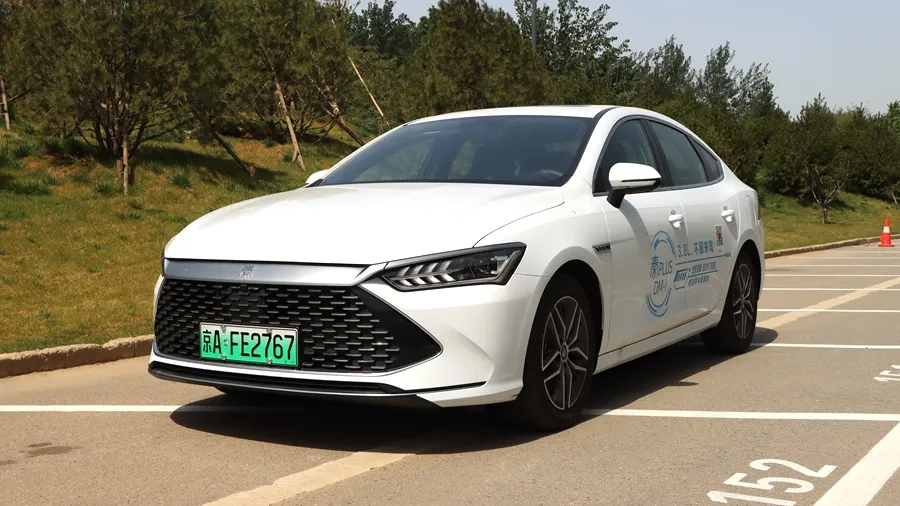Author: Tian Hui
The automotive market welcomes a hardcore model – the Qin PLUS DM-i with a fuel consumption of less than 3.8L per 100km.
Since 2019, the Chinese automotive market has undergone a structural transformation, accelerating the shift from a first-time buyer market to a second-time buyer market. Local independent brands, rooted in China, have taken the initiative in this transformation, with some brands tapping into niche markets and achieving good results.
BYD has focused deeply on the new energy vehicle market.
If the new energy vehicle market is further segmented, BYD can be said to dominate the plug-in hybrid market, having won the annual sales crown for plug-in vehicles for many years.
Starting from the successful development of the first-generation F3DM in 2008, BYD has been quietly cultivating the plug-in hybrid vehicle market for more than 10 years, and has subsequently launched multiple generations of DM2.0-4.0 products, with the most famous models being the Tang DM and Qin DM.
With the two favorable factors of the accelerating shift of the Chinese automotive market from first-time buyers to second-time buyers and the electrification of automobiles, BYD is considering how to popularize plug-in hybrid technology.
DM-i plug-in hybrid technology, along with the first model of the technology, the Qin PLUS DM-i, is BYD’s answer, with advantages in both technology, which can be fueled by both oil and electricity, and super-low fuel consumption, and policy, which is exempt from taxes, purchase restrictions, and driving restrictions.
On April 27th, amid the spring breeze in Beijing, the BYD Qin PLUS DM-i launched in the Beijing area and the first batch of vehicles was delivered to consumers.
Is selling plug-in cars viable in Beijing?
It’s difficult to sell plug-in cars in Beijing.
Beijing has not given any policy advantages to plug-in hybrid new energy vehicles, and consumers in Beijing who purchase plug-in cars face the same restrictions as those who purchase fuel vehicles, which involves using the same passenger vehicle indicators as for fuel cars and limit driving one day a week based on the last number of the workday;
However, purchasing an electric vehicle can obtain more convenient electric vehicle indicators, which are not subject to last number restrictions, and even some district consumers can enjoy government oil-to-electricity subsidies when purchasing a vehicle.
Thus promoting plug-in cars in Beijing is difficult.
From the perspective of insurance coverage, in the first quarter of 2021, the total insurance coverage of plug-in vehicles in the Beijing region is only 667 vehicles, while the insurance coverage of pure electric vehicles reached 18,000 during the same period. Obviously, consumers prefer to buy pure electric vehicles rather than plug-in hybrid vehicles.
But plug-in cars still have sales despite lower numbers. With a vast geographic area in Beijing, the driving restriction limits only apply to the areas within the fifth ring road, making plug-in cars still a viable option for consumers in suburban districts.
Compared with fuel cars, plug-in cars can still enjoy tax exemptions for vehicle purchases. With this advantage, as long as the target market is correctly identified, promoting the BYD Qin PLUS DM-i plug-in car in Beijing is still a viable possibility.Taking Qin PLUS DM-i Prestige as an example, we will compare the comprehensive usage cost with that of the best-selling non-plug-in hybrid car, Toyota Corolla, of the same level.
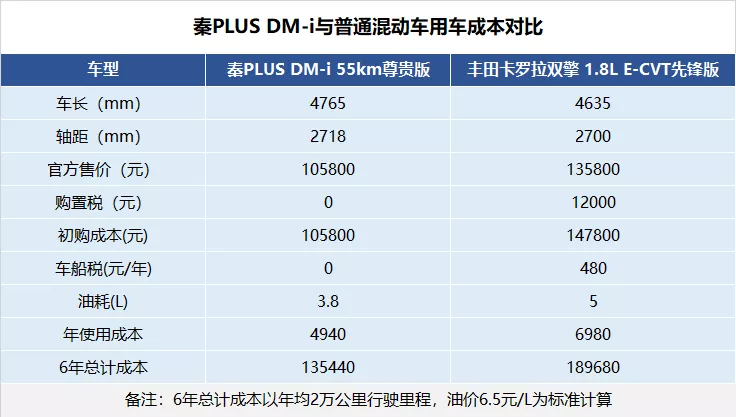
After the relatively larger insurance cost is excluded, when consumers purchase cars, the waiver of 12,000 yuan in purchase tax for Qin PLUS DM-i can cover 48,500 kilometers of driving only on fuel. If consumers have private charging conditions, the saved 12,000 yuan in purchase tax can cover Qin PLUS DM-i charging driving for about 120,000 kilometers.
Even when comparing the annual usage costs of Qin PLUS DM-i and Corolla Hybrid non-plug-in when only fueled and driving 20,000 kilometers per year, Qin PLUS DM-i still has a lower annual usage cost, saving over 2,000 yuan per year.
If we limit the analysis to the first purchase cost and the total 6-year usage cost, and exclude the relatively larger insurance cost, the 6-year comprehensive usage cost of Qin PLUS DM-i is 54,240 yuan less than that of the Toyota Corolla hybrid model.
While it may be challenging for BYD to promote Qin PLUS DM-i in Beijing, looking at the three dimensions of initial purchase cost, annual usage cost, and 6-year comprehensive usage cost, the right marketing approach can lead to good results.
BYD hopes to leverage the benefits of tax reductions, low fuel consumption, and low usage cost to promote Qin PLUS DM-i in suburban areas, aiming to make their product the “king of the suburbs” or the optimal way to promote Qin PLUS DM-i in Beijing.
DM-i: Both Powered by Gas and Electricity
Qin PLUS DM-i uses the DM-i super hybrid technology, consisting of the Joylong 1.5L plug-in engine, EHS hybrid system, and the super hybrid designed blade battery.
What’s most commendable about the technology is the Joylong 1.5L plug-in engine, with a thermal efficiency of 43%, which is at the world’s leading level.
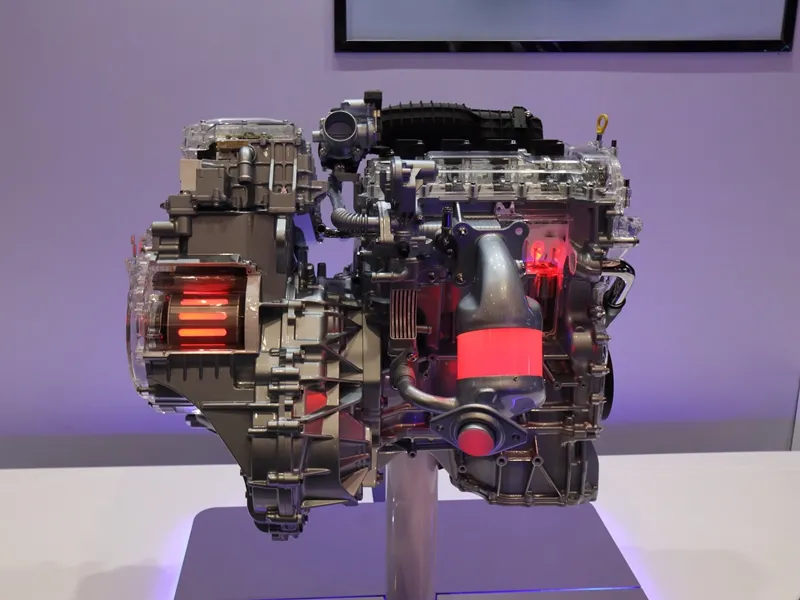
To achieve the thermal efficiency of 43%, BYD correctly applied both addition and subtraction techniques.
Addition-wise, BYD improved the combustion efficiency by changing the engine combustion conditions to the Atkinson cycle and increasing the compression ratio of the engine to 15.5.
Subtraction-wise, they reduced energy consumption losses from various areas such as exhaust, cooling, pumping, friction, and accessories.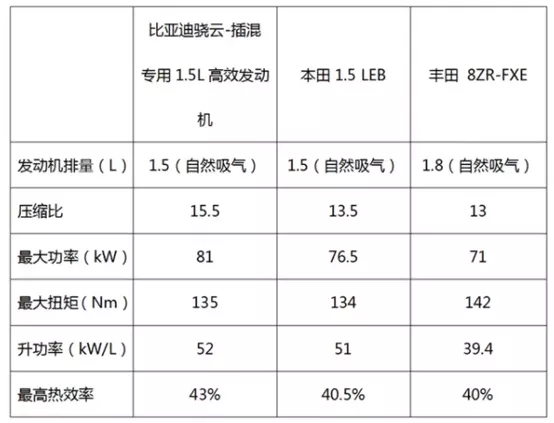
It is worth mentioning that, even compared with the Atkinson cycle engine of Japanese hybrid cars, the BYD Qin Plus DM-i 1.5L plug-in hybrid dedicated engine is also at the forefront in terms of technical parameters.
“More electric, less fuel” – six words summarize the design concept of the EHS hybrid system of the Qin Plus DM-i.
Based on electric power drive, the EHS hybrid system equipped in Qin Plus DM-i is designed to have the characteristics of low-speed range extension and high-speed direct drive.
In terms of driving mode, the DM-i technology combines series hybrid and parallel hybrid modes.
To achieve energy-saving goals under city and highway driving conditions with battery depletion, the system coordinates among series, parallel, and pure electric modes.
During driving, Qin Plus DM-i supports four different driving modes: EV pure electric, HEV series hybrid, HEV parallel hybrid and engine direct drive, which correspond to different driving scenarios.
In EV pure electric mode, the driving motor is powered by the power battery to drive the vehicle without the need for gear shifting. The driving experience is similar to that of a pure electric car, smooth and quiet.
In HEV series hybrid mode, the 1.5L plug-in hybrid dedicated engine drives the generator to generate electricity, and then the EHS hybrid system outputs the electric energy to the motor for driving the wheels. This mode can also be called the range extension state.
In HEV parallel hybrid mode, the 1.5L plug-in hybrid dedicated engine drives the generator to generate electricity to supply the motor energy. Meanwhile, the power battery also outputs electric energy to supply the motor energy. Through the dual-output of oil and electricity, the strongest power of the DM-i system is unleashed.
The engine direct drive mode is applied to highway cruising scenarios where the engine directly drives the wheels. The low consumption characteristics of the engine during high-speed cruising stage are fully utilized to reduce fuel consumption.
In practical use, the four modes can be intelligently adjusted in real-time through the vehicle’s computer.
Challenge the A-class Family Sedan Market
The world belongs to those who win the A-class family sedan market. Qin Plus DM-i is targeted at this market.
The vehicle is 4765mm in length, 1837mm in width, and 1495mm in height, with a wheelbase of up to 2718mm. It belongs to the large compact class sedan in the A-class sedan market and performs well in terms of interior space.
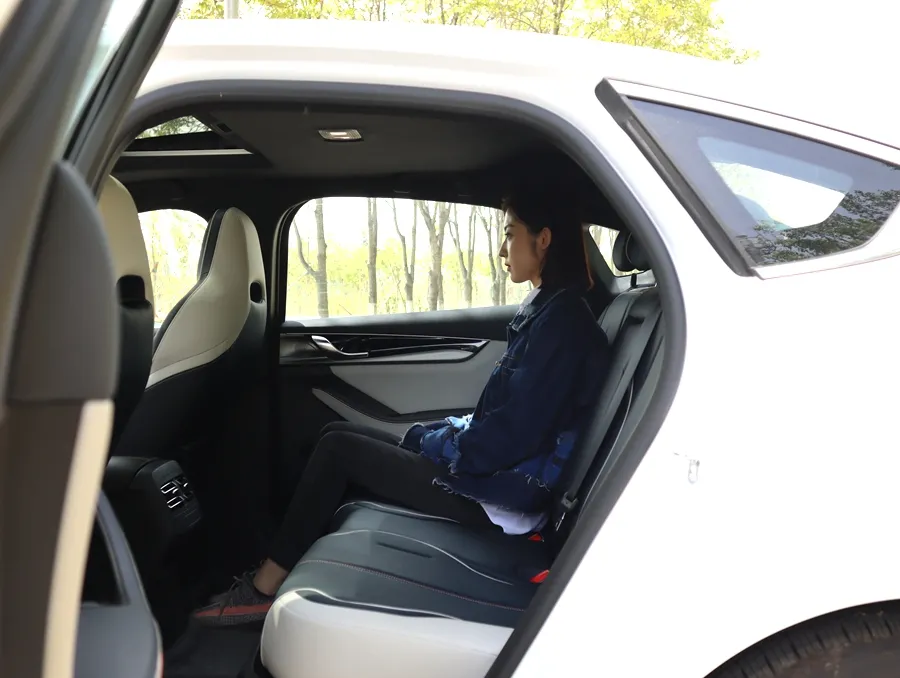 Thanks to its long wheelbase, the Qin PLUS DM-i has good performance in the rear space. During the test drive before the launch event, we experienced the car’s spaciousness. Even with four adult passengers, each person can have comfortable seating space.
Thanks to its long wheelbase, the Qin PLUS DM-i has good performance in the rear space. During the test drive before the launch event, we experienced the car’s spaciousness. Even with four adult passengers, each person can have comfortable seating space.
In terms of appearance, the upgraded DragonFace 2.0 design style of the Qin PLUS DM-i has a wider front face design and applies a matte chrome trim, creating a sense of class in the visual design of the front of the car.
The body side of the Qin PLUS DM-i has a more streamlined design, and the chrome trim on the front fender increases the sense of movement of the whole car.
In terms of rear design, the Qin PLUS DM-i adopts the popular smoked black taillight design, and the addition of the “Build Your Dreams” lettering logo improves the outmoded style of BYD’s old logo and is more in line with current trends.
As for the interior, the design elements of the Qin PLUS DM-i inherit the meticulous details of the Han series. For example, the cascading shaped air outlet, which was well received in the Han, is also applied to the Qin PLUS DM-i, highlighting the luxury texture of the entire car.
The entertainment system of the whole car is still BYD’s exclusive rotating screen. Since this test drive model is a lower-equipped version, the size of the rotating screen is slightly smaller, which is the biggest regret in interior design. We recommend that BYD officially release an upgrade service.受制于成本,秦 PLUS DM-i 的高级配置不多,但自动大灯、自动空调依然成为标配,难能可贵的是,秦 PLUS DM-i 还提供了后排空调出风口。
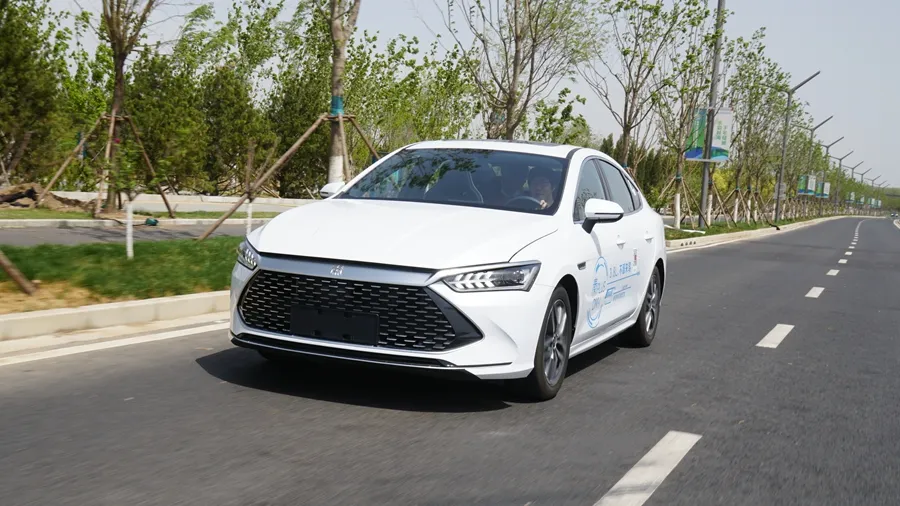
秦 PLUS DM-i 的驾驶感受,更像电动汽车,日常行驶过程中很难察觉到发动机启动时的噪音。
在日常加速、城市驾驶时,秦 PLUS DM-i 将以纯电驱动为主,只有在高速巡航行驶时,燃油发动机将会介入,直接驱动车轮前进。
比亚迪官方宣传的超低油耗,确实不虚,在整个试驾过程中,秦 PLUS DM-i 在满载 4 名成年人,全程开启 22℃ 自动风空调的情况下,日常驾驶平均油耗 < 3.8 L。
试驾过程中,我们尝试进行极限的暴力驾驶,以期望拉高油耗,一窥该车油耗水平的上限。
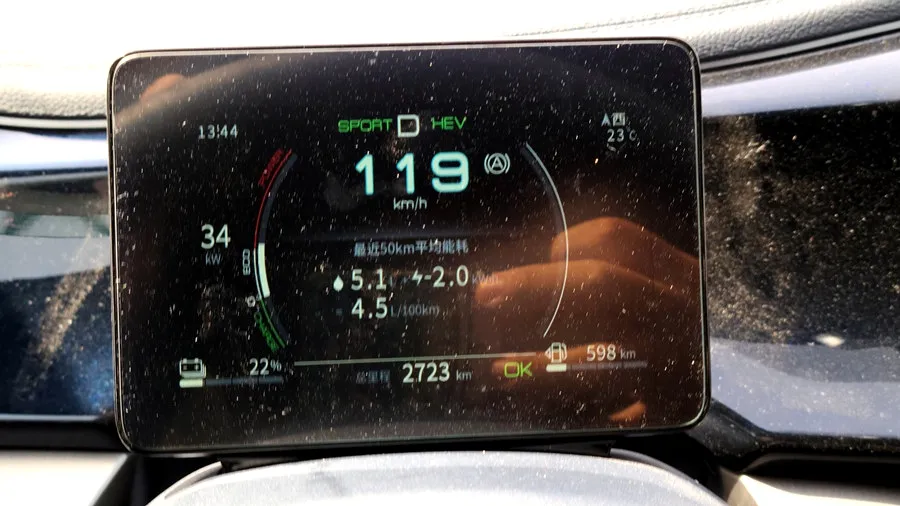
在多次急加速并连续 120 km / h 高速续航行驶后,秦 PLUS DM-i 的平均油耗依旧低于 4.5 L / 100 km,这一能耗水平已低于日系车的能耗水平。
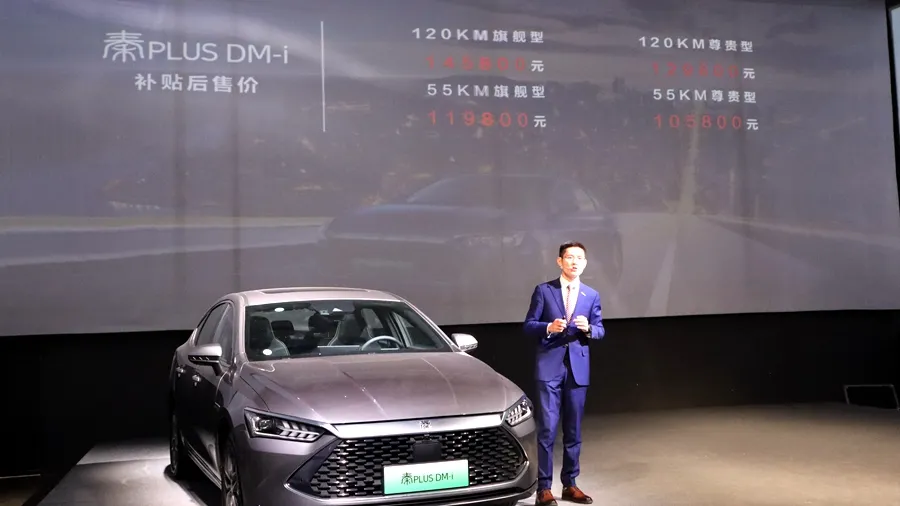
从试驾情况看,在产品力上秦 PLUS DM-i 已超越传统燃油车,但受制于北京市场的特殊政策,比亚迪寄希 秦 PLUS DM-i 撬动北京燃油车的想法,还需在营销与客户服务等多层面共同发力才行。
This article is a translation by ChatGPT of a Chinese report from 42HOW. If you have any questions about it, please email bd@42how.com.
